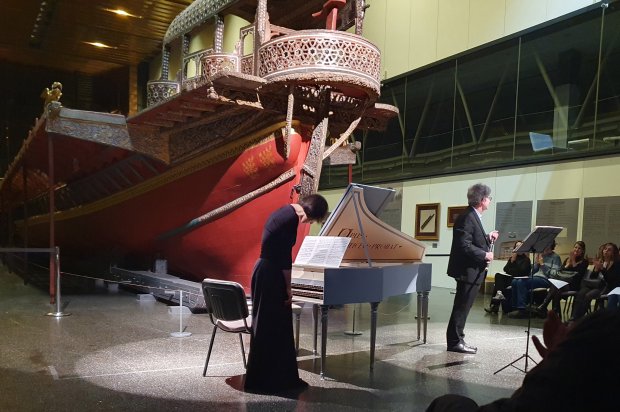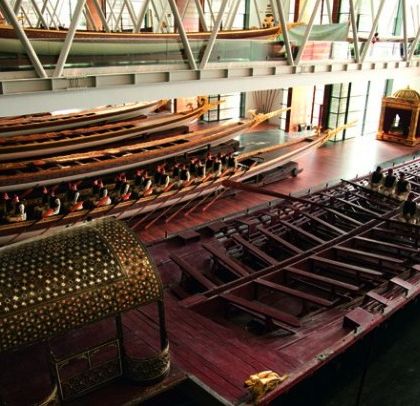On April 27 I attended a concert of chamber music at the Naval Museum in Beşiktaş. This event was part of a music festival organised by an outfit that goes by the name of ‘Opus Amadeus’ in conjunction with Artisan Organizasyon. I believe they hold a festival of chamber music (often with a baroque emphasis) in March, April and May every year. In fact, in March 2020 I was just about to go to one of their concerts when the pandemic struck, so by attending this one I was, in a sense, keeping a promise made to Mr Mehmet Mestçi, the Artistic Director of Opus Amadeus, over three years ago.
Here are links to Opus Amadeus, and to the programme for this year’s festival; although it is now over, you may wish to see what kind of things are typically on offer, and perhaps make a note in your diary for 2024.
http://www.opusamadeus.com/odaMuzigi/index.html
http://www.opusamadeus.com/odaMuzigi/festival-programi.php
The venue was a highly impressive one – the ground-floor hall at the Naval Museum. Displayed within this cavernous space were three of the enormous rowing boats that were used by the Ottoman sultans and their womenfolk when going on expeditions up the Bosphorus or the Golden Horn. Beneath the bows of the most ornate of these craft – a sumptuous affair with intricate wood carvings and inlays of mother-of-pearl – a harpsichord had been set up, making this one of the most eye-catching concert venues I have ever seen. At the far end of the hall was a floor-to-ceiling window, and through it the twinkling lights of Üsküdar, and the silhouettes of steamers coming in to dock at the nearby Barbaros Hayrettin Paşa ferry terminal, were visible.
The performers were a Hungarian duo – baroque flautist Benedek Csalog and harpsichordist Dóra Pétery. Mr Csalog, a graduate of the Franz Liszt Academy in Budapest, teaches the baroque flute at the Leipzig Hochschule für Musik und Theater and at the Bydgoszcz Academy of Music in Poland, and frequently receives invitations to teach at the Tchaikovsky Conservatory in Moscow. Ms Pétery, too, graduated from the Franz Liszt Academy, where her main instrument was the organ; following this, she refined her skills at the Sibelius Academy in Helsinki. She currently teaches in the Church Music department of the Liszt Academy, and apart from being a performer of baroque music is also a contemporary music enthusiast.
The programme began with an arrangement for flute of J.S. Bach’s Violin Sonata in G major, BWV 1021. This was followed by a work by the modern Hungarian composer György Ligeti (1923–2006) entitled Passacaglia Ungherese (1978) in which Ms Pétery played solo. I cannot find a recording on YouTube of the violin sonata being played by a flautist instead of a violinist. However, here is a video, with the score, of the distinctly odd Ligeti piece; it starts out fairly innocuously, but gets weirder and more dissonant as time goes on (I caught some echoes of Frank Zappa). The performer is, unfortunately, unnamed.
Then came the Sonata for Flute and Harpsichord in E minor, BR WFB17, by Wilhelm Friedemann Bach (1710–84), the second child and eldest son of Johann Sebastian and his first wife Maria Barbara Bach. (She died, suddenly and unexpectedly, when he was nine, and his father remarried.) Wilhelm Friedemann, though given a thorough musical education by his father and widely acknowledged in his time to be an excellent improvisor, did not have a successful career – possibly as a result of the ‘wayward and difficult’ personality described by his biographers – and died in poverty. It was obvious from the outset that Mr Benedek Csalog is a highly-accomplished flautist. He had to be: in the first movement of the W.F. Bach Sonata there were so many extended fast-running passages that I wondered how he ever found time to breathe. At the end of it, right on cue, the call to prayer was heard from a nearby mosque.
In this recording of the work, the flautist is Barthold Kuijken and the harpsichordist Ewald Demeyere.
Mr Csalog then retired from the scene, leaving the floor to Ms Dóra Pétery for a performance of four movements of J.S. Bach’s Partita No. 6 in E minor, BWV 830. I confess that I did not find this part of the concert entirely satisfactory. The reason may perhaps have been that I am used to hearing this work performed on the piano rather than the harpsichord; however, the frequency of wrong notes may also have had something to do with it. (This surprised me, as Ms Pétery had already proved herself to be a perfectly competent accompanist.) This being said, I will pass on, and invite the reader to listen to the Partita being played by Grigory Sokolov.
The last work on the programme was C.P.E. Bach’s Sonata for Flute and Harpsichord in C major, Wq. 149, H.574. Carl Philipp Emmanuel (1714-1788) was Johann Sebastian’s second surviving son, and thus Wilhelm Friedemann’s younger brother. Better adapted to wordly affairs than his elder sibling, after graduating from university he obtained a post in the service of Crown Prince Frederick of Prussia (the future ‘Frederick the Great’). Even at this early age, he was already one of Europe’s foremost keyboard-players, and spent much of his time in Berlin composing sonatas for the harpsichord and clavichord. His treatise entitled Versuch über die wahre Art das Clavier zu spielen (‘An Essay on the True Art of Playing Keyboard Instruments’) was a definitive and highly influential manual of keyboard technique that drew fulsome praise from both Haydn and Beethoven. It contains information on how ornaments such as trills and turns were actually played in the works of the period; this information is extremely useful from our point of view as in the absence of contemporary sound recordings, the question of what the performer was expected to do with the squiggles (indicating trills, turns and mordents) that J.S. Bach and others sometimes wrote above the notes they wrote would otherwise be an extremely vexed one.
Here is C.P.E. Bach’s Sonata for Flute and Harpsichord played by flautist Luis Martínez Pueyo and harpsichordist Adrià Gràcia Gàlvez.
In the performance of this work at the Naval Museum in Beşiktaş, co-ordination between flute and harpsichord was exemplary. During the brief interval that preceded the last movement, there was another call to prayer – timed, yet again, with faultless accuracy. As an encore, the Hungarian duo gave us a work by Johann Joachim Quantz (1697–1773), a composer, flautist and flute-maker who from the age of 9 received training in his father’s profession – that of blacksmith – but ended up teaching the flute to Frederick the Great. Quantz wrote a treatise on flute-playing that was entitled (astonishingly, perhaps) ‘On Playing the Flute’.
It seems that Mr Mehmet Mestçi, the leading light in Opus Amadeus, received his initial training as a flautist at the Hacettepe University State Conservatoire in Ankara, and subsequently studied the flute at the Debrecen Conservatory, an institution attached to the Franz Liszt Academy in Budapest. (I wonder if there might be a connection with Messrs Csalog and Pétery here?) He then wrote a thesis on Peter Maxwell Davies’s Missa super l’homme armé at Edinburgh University. His ‘Istanbul International Opus Amadeus Chamber Music Festivals’ have been going since 2012, and I congratulate him both on this initiative and on his many other efforts to provide us with concerts of high-quality classical music.
I cannot leave you without bringing to your attention this recording of the Missa super l’homme armé. Do not listen if in a sensitive frame of mind, or if constitutionally out of synch with modern conceptions of musical aesthetics. But whatever your approach to issues of this nature may be, you are hereby cautioned to be ready with a humorous attitude and a salt cellar well-filled enough to provide several generous pinches. One last word: if baby-sitting, be sure to turn down the volume.





_The_Golden_Horn_at_Dusk_c._1900_140_92_80.jpg)


